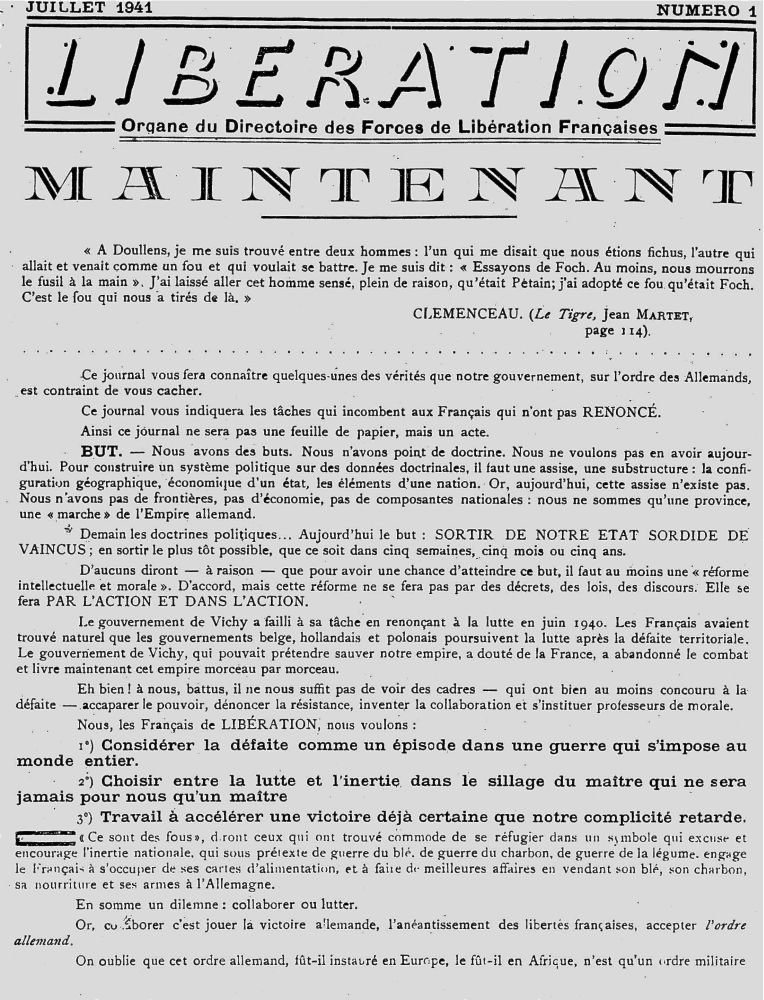Libération -zone Sud n°1, juillet 1941
Légende :
Une du journal Libération (zone Sud) n°1, juillet 1941
Front page of the newspaper Libération (zone Sud) Number 1, July, 1941
Genre : Image
Type : Presse clandestine
Producteur : Bibliothèque Nationale de France (BNF)
Source : © BNF - Gallica Droits réservés
Détails techniques :
Journal imprimé.
Date document : Juillet 1941
Lieu : France
Analyse média
Ce premier numéro du journal fondé par Emmanuel d’Astier de la Vigerie et Jean Cavaillès, qui bénéficiera des contributions d’André Lassagne et Raymond Aubrac, paraît en juillet 1941, et a été tiré à 10 000 exemplaires. C’est le journal du mouvement de résistance Libération-Sud. Il porte en sous-titre « Organe du Directoire des Forces de Libération Française » et a plus l’aspect d’un tract que celui d’un journal.
Il commence par un gros titre et une citation de Clemenceau dénonçant l’attitude du maréchal Pétain pendant la Première Guerre mondiale. Ce journal se présente comme une suite de courts paragraphes opposant l’avenir – temps dévolu à l’élaboration de doctrines politiques – par rapport au présent, qui doit être résolument tourné vers l’action et vers les tâches qui incombent à ceux qui veulent résister aux occupants et à Vichy.
This first edition of the journal founded by Emmanuel d'Astier de la Vigerie and Jean Cavaillès, which benefited from contributions from André Lassagne and Raymond Aubrac, appearing in July 1941, made 10,000 copies. Libération was the clandestine newspaper of the Résistance movement Libération-Sud. Its subtitle stated: “Executive Organ of the Directory of the French Résistance” and had a penchant as a pamphlet more than as a journal.
This particular edition begins with a title and a quote from Clemenceau denouncing the attitude of Pétain during the First World War. The newspaper contains short paragraphs opposing the future – a time being devoted to the development of policy doctrines - and the present, to be decidedly turned towards the tasks that encumbered those who wanted to resist against the Occupation and the Vichy government.
Alain Giacomi
Traduction : Sarah Buckowski
Contexte historique
Sur le journal (1)
Libération-Sud, créé en juillet 1941, est issu de la Dernière Colonne, groupe mené par Emmanuel d'Astier de la Vigerie. Destiné au recrutement et à l'implantation du mouvement, le journal dispose d'un service de propagande-diffusion dirigé par Jules Meurillon.
Rédigé à Lyon, imprimé à Montélimar, Auch puis Toulouse, diffusé dans la zone Sud jusqu'en 1944, son tirage atteint 300 000 exemplaires. Antivichyste et antinazi, gaulliste à l'été 1942, il souhaite un régime futur fondé sur la démocratie et l'égalité sociale.
Sur les événements de la période (2)
Ce journal sort à un moment où, dans la zone occupée, la répression (arrestation d’Honoré d’Estienne d’Orve le 21 janvier et démantèlement en février du réseau du Musée de l’Homme) et la persécution (second statut des juifs, le 2 juin) s’accentuent. Dans le même temps, et cela explique l’appel à se ressaisir et à lutter lancé par le journal, des signes de mécontentement de plus en plus nombreux apparaissent dans un contexte d’aggravation des pénuries, ainsi qu’en témoignent, notamment à Marseille, la multiplication des tracts gaullistes et anglophiles. Les forces résistantes continuent ainsi de s’organiser avec, entre autres, le 30 mars, la formation du Comité d’action socialiste (CAS) en zone Sud et, le 15 mai, l’appel du PCF invitant à créer un Front national pour l’indépendance de la France.
Sur le plan international, le déclenchement de l’opération Barbarossa en juin 1941 (invasion par les troupes allemandes de l’URSS) marque l’ouverture du front de l’Est qui devient le principal théâtre terrestre des opérations militaires en Europe.
The newspaper
“Libération-Sud”, created in July 1941, derived from la Dernière Colonne, a group created by Emmanuel d'Astier de la Vigerie. Designed to attract members to the movement, the paper had a service of propaganda and distribution directed by Jules Meurillon.
Drawn up in Lyon, printed in Montélimar, Auch and then Toulouse, distributed in the Southern zone until 1944, printing 300,000 copies. This anti-Vichy, anti-Nazi newspaper turned Gaullist in the summer of 1942, wished for a future regime founded on both democracy and social equality.
Concerning events during the period
This paper was released at a time when the occupied zone was under strong repression (the arrest of Honoré d'Estienne d'Orve on January 12th and in the following month the dismantling of the “Musée de l'Homme” network) and persecutions (the second statute of the Jews, on June 2nd) multiplied. Due to all this happening at the same time the paper echoed a call to fight and resist the current oppression, as more and more signs of discontent grew among the population, in particular regarding the overall shortages. Gaullist pamphlets, notably in Marseille were already echoing the situation. The Résistance forces continued to organize, until the creation,on March 30th, of the Comité d'Action Socialiste”(CAS) in the Southern zone, and on May 15th the call of the French Communist Party proposing the creation of a national front for French Independence.
At the international level, the launch of Operation Barbarossa in June 1941 (the German invasion of the USSR) marked the opening of the Eastern front which became the principal ground theater for military operations in Europe.
Cécile Vast, "Libération-Sud" in Dictionnaire historique de la Résistance (dir. François Marcot), Robert Laffont, Paris, 2006 (1).
Alain Giacomi (2)
Traduction : Sarah Buckowski

Journal Libération (zone Sud) n°1, juillet 1941, page 2
Gallica - Bibliothèque nationale de France
 Libération zone Sud n°1, juillet 1941
Libération zone Sud n°1, juillet 1941Journal Libération (zone Sud) n°1, juillet 1941, page 3
Gallica - Bibliothèque nationale de France
 Libération zone Sud n°1, juillet 1941
Libération zone Sud n°1, juillet 1941Journal Libération (zone Sud) n°1, juillet 1941, page 4
Gallica - Bibliothèque nationale de France



 Voir le bloc-notes
()
Voir le bloc-notes
()